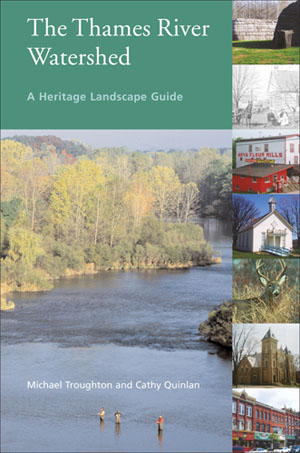
The Thames River Watershed: A Heritage Landscape Guide
The Thames River Watershed: A Heritage Landscape Guide is primarily the work of the late Michael Troughton, a geographer and, for more than 30 years, a professor at the University of Western Ontario in London. Dr. Troughton was keenly interested in the geography and human settlement of southwestern Ontario. This book is a culmination of his knowledge and love of the natural and cultural landscape of the Thames and Lake Erie watersheds.
The guide was published with assistance of a grant from the Ontario Trillium Foundation, an agency of the Government of Ontario. For over 25 years, the Foundation has supported the growth and vitality of communities across the province. It continues to strengthen the capacity of the volunteer sector through investments in community-based initiatives.
From the introduction:
The Thames is a major river in Southern Ontario, and its watershed encompasses a significant portion of the extreme southwest of the province. Home to more than 500,000 people, the Thames watershed contains all or parts of seven counties and 54 municipalities. Nestled in one of the most productive agricultural areas in Canada, with an array of distinctive and charming rural farm and village landscapes, it also contains the cities of London, Chatham, Stratford and Woodstock within one of Canada’s major urban corridors running from Windsor to Montreal.
In this guide, we describe the natural and cultural heritage of the Thames watershed and some of the most interesting sites within and close to the region. We divide the watershed into six major “landscapes,” and describe a total of 45 representative sites within these selected landscapes. The purpose of this guide is twofold: to provide a background to the watershed and to serve as an introduction to its exploration.
The landscapes of the Thames watershed, especially the extensive rural areas, are subtle rather than spectacular. Characterized by broad expanses, in places gently rolling, the landscape yields many clues to the influence of the last Ice Age in shaping the forms and patterns that exist today.
The cultural history of the watershed is likewise imprinted on the landscape. The formative influence of First Nations peoples, the significance of the Thames region to black settlers escaping slavery, the impact of European settlement on the forests and wetlands as these early settlers carved prosperity out of the region’s fertile soils – the heritage is rich.
And sometimes surprising. Timothy Eaton opened his first store in the village of Kirkton. The foundry in the hamlet of Fingal manufactured Canada’s first threshing machine. Most towns and even some villages had a theatre and opera house in the 19th century. Canada’s first cheese factory was in Ingersoll. The Tecumseh Hotel in London was, for a brief period, the largest in the country.
By promoting greater awareness of the physically varied, historically significant and visitor-friendly watershed, we hope to encourage a richer understanding of this diverse, dynamic region.

